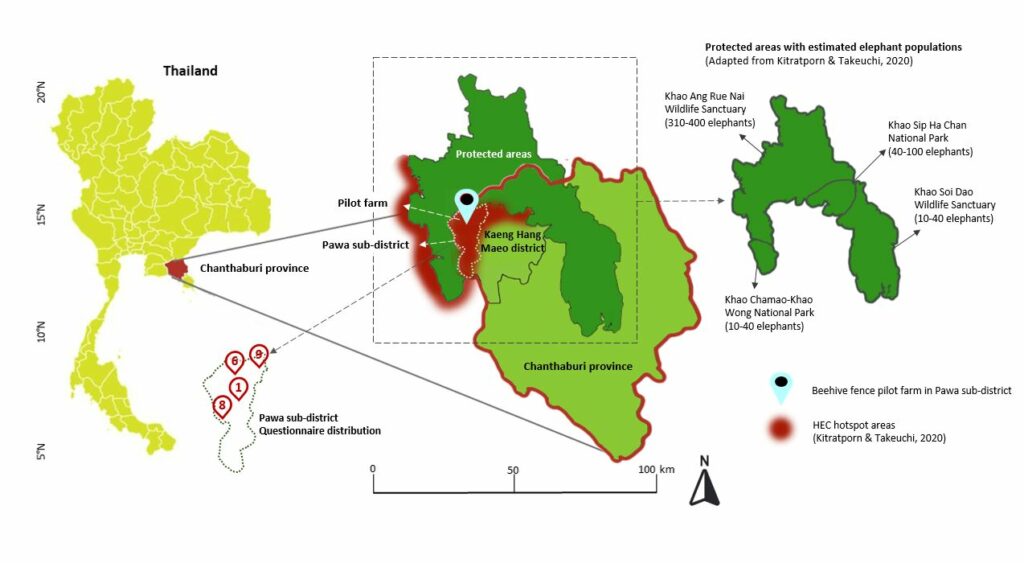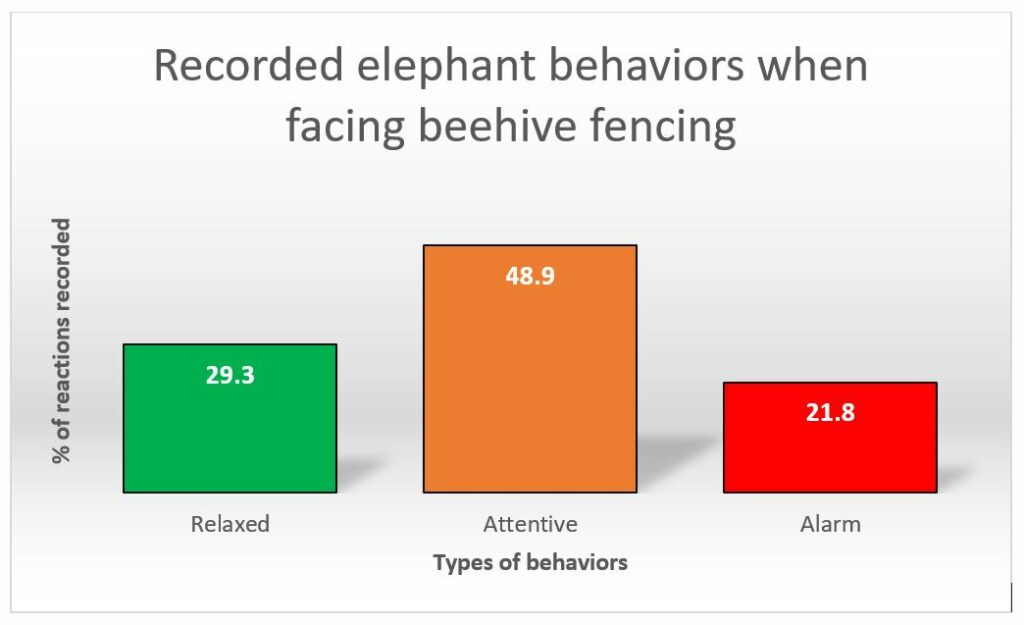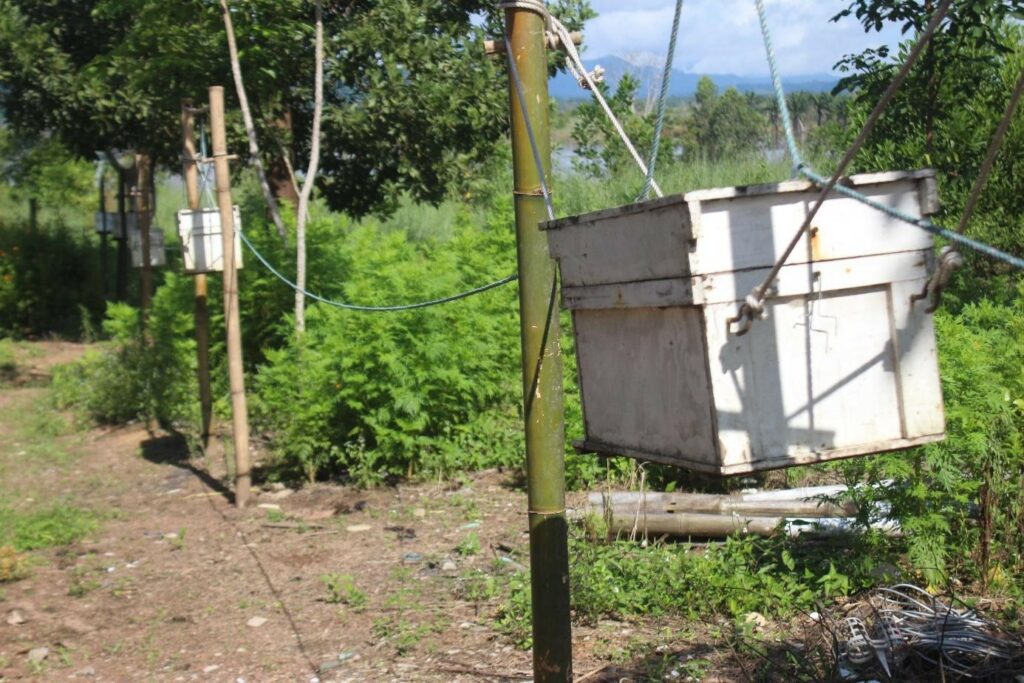Bees take on the duty to prevent crop field intrusions and foster peaceful coexistence of elephants and farmers in Thailand.
The recent agricultural expansion in what was previously elephant territory led to more conflicts between majestic elephants and farming communities living on the outskirts of the old-growth forests. Both human and elephant populations are increasing and have a crucial need for vital resources such as water and crops. But conflict is not inevitable, and our mission is to ensure local communities find a peaceful way to prevent elephants from intruding on their territory. To fulfil this aim, the use of beehive fences is a win-win solution.
Beehive fences can reduce crop damage by Asian elephants and generate supplemental income for farmers in Thailand. As such, they have the potential to prevent violent conflicts between people and the world’s largest land animals and establish new forms of peaceful coexistence.
Our study was conducted in Kaeng Hang Maeo district of Chanthaburi province in Eastern Thailand, an area of high human-elephant conflict, consisting of farmland surrounded by Protected Areas.
Our research team first gained insight into the local communities’ attitudes towards elephants. It appeared that the majority of households encountered elephants at least once a week, had experienced negative impacts from elephants including damage to crops and property and that these problems were increasing. Most farmers had not gained any benefit from living with elephants. Nevertheless, two-thirds of the respondents reported being tolerant towards elephants, if only they would stop causing damage. It indicated the need for solutions that combined elephant damage reduction with benefits for local people.
Bees and elephants research
Elephants even have a specific bee alarm rumble vocalization they use to warn others, so they dissuade other elephants to raid. Implementing such a deterrence method can also help fostering research on vocalization and communication in elephants, and as you can see in the videos, it creates wonderful observation opportunities.



Bees have the potential to deter elephants as well as provide additional income to farmers from honey. To evaluate this idea, we set up a pilot beehive fence. We surrounded a 0.4 ha subsistence farm with a 250m fence, on which 40 beehives were suspended. The beehives were outfitted with a low-cost trigger mechanism developed by a regional wildlife research station, which opens the hives to activate dormant bees, as soon as elephants try to break the fence at night. Camera-traps on trees near the fence recorded the elephants’ reactions. The results of this pilot study indicated that over 60% of the elephant groups and over 85% of the individual elephants were deterred by the newly installed beehive fence. The elephants that came close to the beehive fence showed typical signs of increased alertness and uncertainty and often slowly backed away. The farm owner reported a strong reduction in crop damage after the beehive fence was installed, as well as additional benefits, including the supplemental income from honey and honeybee queens.
Our research team suggest that, for maximum impact, beehive fences can be combined with complementary methods such as growing crops unattractive to elephants. For instance, the farm owner in this study started growing chilli and lemongrass along the beehive fence as an extra barrier – and as a source of income. For more details about alternative crops to prevent crop-raiding, check out BTEH’s Tom Yum project.
The implementation of beehive fences might be prioritized on smaller farms that are close to significant elephant populations or located along commonly utilized elephant pathways.




Beehives were outfitted with a low‐cost trigger mechanism developed by the Phuluang Wildlife Research Station, which opens the hives to activate dormant bees during fence‐breaking attempts occurring at night. The hive opens when an elephant pushes the rope and closes again when the rope is released.
About this study
This study was a collaboration of Bring The Elephant Home Foundation, the Phuluang Wildlife Research Station, Project Dragonfly of Miami University, the Future for Nature Academy and the Elephants and Bees project of Save the Elephants.
The beehive fence research “Beehive fences as a sustainable local solution to human‐elephant conflict in Thailand” has been published in Conservation Science and Practice in August, 2020.
Authors: Antoinette van de Water, Lucy E. King, Rachaya Arkajak, Jirachai Arkajak, Nick van Doormaal, Viviana Ceccarelli, Liesbeth Sluiter, Suzan M. Doornwaard, Vera Praet, David Owen and Kevin Matteson.
More research on beehive fences with similar results as our study (about 80% deterrence):
King, L. E., Lala, F., Nzumu, H., Mwambingu, E., & Douglas-Hamilton, I. (2017). Beehive fences as a multidimensional conflict-mitigation tool for farmers coexisting with elephants. Conservation Biology, 31(4), 743–752.
Our related research: “Human-elephant conflict in western Thailand: Socio-economic drivers and potential mitigation strategies” has been published in the scientific journal PlosOne in June 2018.

Bee the Change!
We are looking for donations to support the implementation of beehive fences in combination with our new Tom Yum project, in human-elephant conflict areas. Please donate online through the form below or shop at Elephant & Co. Your support will help people and elephants directly and will contribute to a world in which people and animals can coexist peacefully.
News and updates
2024-03-02 Series of Adventures in Ruam Thai Village as a visiting researcher
2022-04-30 Community meeting with the Ruam Thai Beekeeping Group
